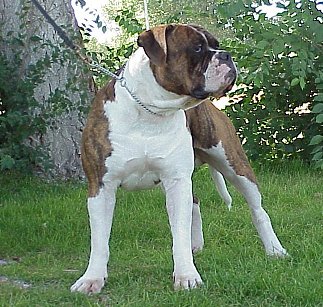
|
|
The American Bulldog has ONE written standard in the UKC. The American Bulldog was first recognized by the UKC on January 1, 1999. |
Bulldogs in England were originally working dogs who drove and caught cattle and guarded their masters' property. The breed's strength, courage, and familiarity with livestock led to its popularity in the brutal sport of bull baiting. When this sport was outlawed in England, the original type of Bulldog disappeared from Britain and was replaced with the shorter, stockier, less athletic dog we now know as the English Bulldog.
The original Bulldog, however, was preserved by working class immigrants who brought their working dogs with them to the American South. Small farmers and ranchers used this all-around working dog for many tasks. By the end of World War II, however, the breed was almost extinct. Mr. John D. Johnson, a returning war veteran, decided to resurrect this breed. Along with Alan Scott and several other breeders, Johnson began carefully to breed American Bulldogs, keeping careful records and always with an eye for maintaining the breed's health and working abilities.
Because of the many different types of work this breed can do, several distinct lines evolved, each emphasizing the traits needed to do a specific job. The best known lines are usually referred to as the Johnson and Scott types. The Johnson dogs are more massive, with a larger, broader head and shorter muzzle, and a definite undershot bite. The Scott dogs were somewhat lighter in musculature and bone than the Johnson dogs, with a less Mastiff-like head. Today, however, most American Bulldogs have crosses to two or more of these lines and are not as easily distinguishable.
The modern American Bulldog continues to serve as an all-purpose working dog; a fearless and steady guard dog; and a loyal family companion.
General Appearance:
The
American Bulldog is a powerful, athletic short-coated dog, strongly muscled,
and well boned. The body is just slightly longer than tall. The head is
large and broad with a wide muzzle. Ears are small to medium in size, high
set, and may be drop, semi-prick, rose, or cropped. The tail may be docked
or natural. The American Bulldog comes in solid colors, white with colored
patches, and brindle. Gender differences are well expressed in this breed,
with males typically larger and more muscular than females. Honorable scars
resulting from field work are not to be penalized. The American Bulldog
should be evaluated as a working dog, and exaggerations or faults should
be penalized in proportion to how much they interfere with the dog's ability
to work.
Characteristics:
The
essential characteristics of the American Bulldog are those which enable
it to work as a hog and cattle catching dog, and a protector of personal
property. These tasks require a powerful, agile, confident dog with a large
head and powerful jaws. The American Bulldog is a gentle, loving family
companion who is fearless enough to face an angry bull or a human intruder.
Note: It is common for young American Bulldogs to be somewhat standoffish
with strangers and judges should not penalize this. By the time the dog
is around 18 months of age, however, the breed's normal confidence asserts
itself. Disqualifications:
Viciousness or extreme shyness; cowardice.
Head:
The
head is large and broad giving the impression of great power. When viewed
from the side, the skull and muzzle are parallel to one another and joined
by a well-defined stop. The stop is very deep and abrupt, almost
at a right angle with the muzzle. Despite
the depth of the stop, the forehead is wider than it is high.
SKULL -- The skull is large, flat, deep, and broadd between the ears. Viewed from the top, the skull is square. There is a deep median furrow that diminishes in depth from the stop to the occiput. Cheek muscles are prominent.
MUZZLE -- The muzzle is broad and thick with a veryy slight taper from the stop to the nose. The length of the muzzle is equal to 35 to 45 percent of the length of the head. Lips are moderately thick but not pendulous. The chin is well defined and must neither overlap the upper lip nor be covered by it.
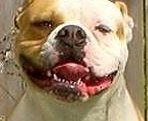 |
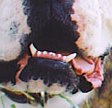 |
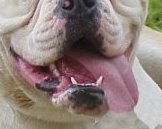 |
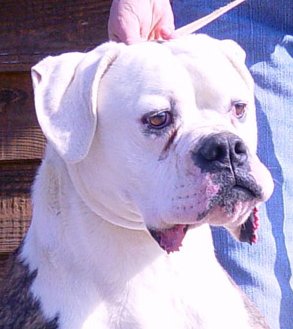 |
Disqualification: Overshot.
NOSE -- The nose is large with wide, open nostrills. The nose may be any color but darker pigment is preferred.
 |
 |
 |
 |
 |
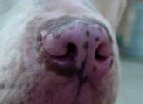 |
Faults: Very visible haws.
 |
 |
 |
|
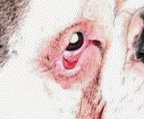 |
Drop ears: The ears are set high, level with the upper line of the skull, accentuating the skull's width. At the base, the ear is just slightly raised in front and then hangs along the cheek. The tip is slightly rounded. When pulled toward the eye, the ear should not extend past the outside corner of the eye.
Semi-prick ears: Same as drop ears except that only the tips of the ears drop forward.
Rose
ears: Rose ears are small and set high on the skull.
Fault:
Hound ears.
 |
 |
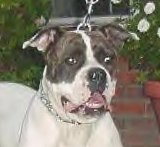 |
 |
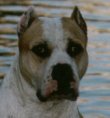 |
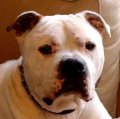 |
|
The neck is where the American Bulldog exerts power to bring down livestock. The neck must be long enough to exert leverage, but short enough to exert power. The neck is muscular and, at its widest point, is nearly as broad as the head, with a slight arch at the crest, and tapering slightly from shoulders to the head. A slight dewlap is acceptable.
Faults: Neck too short and thick; thin or weak neck.
Forequarters:
The
shoulders are strong and well muscled. The shoulder blade is well laid
back and forms, with the upper arm, an apparent 90-degree angle. The tips
of the shoulder blades are set about 2 to 3 finger-widths apart.
The forelegs are heavily boned and very muscular. The elbows are set on a plane parallel to the body, neither close to the body nor turned out. Viewed from the front, the forelegs are perpendicular to the ground or may, especially in a dog with a very broad chest, incline slightly inward. The pasterns are short, powerful, and slightly sloping when viewed in profile. Viewed from the front, the pasterns are straight.
Body:
The
chest is deep and moderately wide with ample room for heart and lungs.
The ribs are well sprung from the spine and then flatten to form a deep
body extending at least to the elbows, or lower in adult dogs. The topline
inclines very slightly downward from well-developed withers to a broad,
muscular back. The loin is short, broad, and slightly arched, blending
into a moderately sloping croup. The flank is moderately tucked up and
firm.
Serious
faults: Swayback; sloping topline.
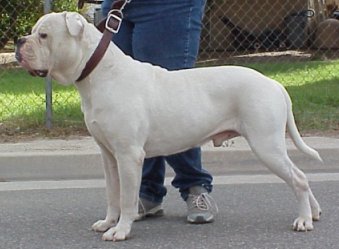 |
 |
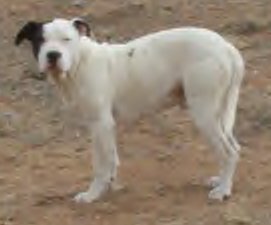 |
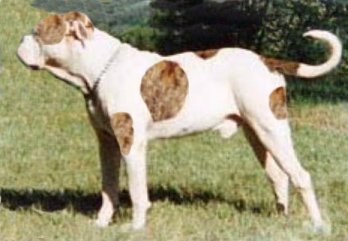 |
The hindquarters are well muscled and broad. The width and angulation of the hindquarters is in balance with the width and angulation of the forequarters. The thighs are well developed with thick, easily discerned muscles. The lower thighs are muscular and short. Viewed from the side, the rear pasterns are well let down and perpen-dicular to the ground. Viewed from the rear, the rear pasterns are straight and parallel to one another.
Faults: Cowhocks; open hocks.
Serious faults: Narrow or weak hindquarters.
|
|
|
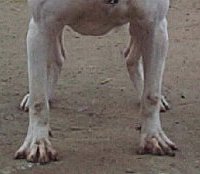 |
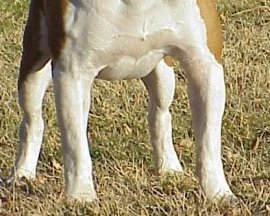 |
The feet are round, medium in size, well arched, and tight.
Fault: Splayed feet. The seriousness of this fault is based on the amount of splay in the feet.
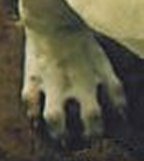 |
 |
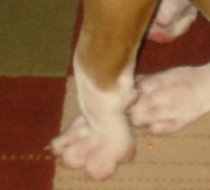 |
 |
The American Bulldog may have a natural or a docked tail, but the natural tail is preferred. The natural tail is very thick at the base, and tapers to a point. The tail is set low. A "pump handle" tail is preferred but any tail carriage from upright, when the dog is excited, to relaxed between the hocks is acceptable.
Serious fault: Tail curled over the back; corkscrew tail; upright tail when the dog is relaxed.
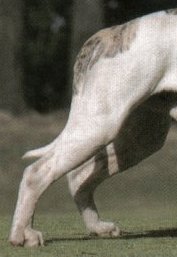 |
 |
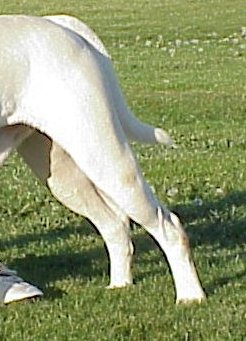 |
 |
|
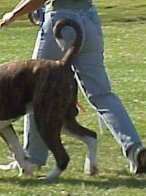 Curled over back
Curled over back |
 |
The coat is short, close, and stiff to the touch.
Disqualifications: Long or wavy coat.
 |
 |
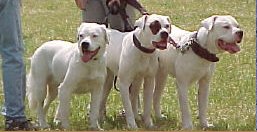 |
Any color, color pattern, or combination of colors is acceptable, except for solid black, solid blue, and tricolor (white with patches of black and tan). Some dark brindle coats may appear black unless examined in very bright light. A buckskin color pattern, where the base of the hair is fawn and the tips are black, may also appear solid black. A judge should not disqualify an American Bulldog for black color unless the dog has been examined in sunlight or other equally bright light.
Disqualifications: Solid black or blue with no white markings; tricolor (white with patches of black and tan).
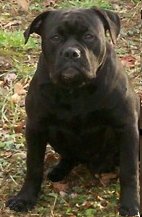 |
|
|
The American Bulldog must be sufficiently powerful and agile to chase, catch, and bring down free-ranging livestock. Dogs capable of doing this come in a rather wide range of height and weight. Males are typically larger with heavier bone and more muscle than females. Both sexes, however, should have a well-balanced overall appearance.
Desirable height in a mature male ranges from 22 to 27 inches; in a mature female, from 20 to 25 inches. Desirable weight in a mature male ranges from 75 to 125 pounds; in a mature female, from 60 to 100 pounds.
Gait:
When
trotting, the gait is effortless, smooth, powerful and well coordinated,
showing good reach in front and drive behind. When moving, the backline
remains level with only a slight flexing to indicate suppleness. Viewed
from any position, legs turn neither in nor out, nor do feet cross or interfere
with each other. As speed increases, feet tend to converge toward center
line of balance. Poor
movement should be penalized to the degree
to which it reduces the American Bulldog's ability to perform the tasks
it was bred to do.
Disqualifications:
Unilateral
or bilateral cryptorchid. Viciousness or extreme shyness. Unilateral or
bilateral deafness. Cowardice. Overshot. Long or wavy coat. Albinism. Solid
black or blue with no white markings. Tricolor (white with patches of black
and tan).

